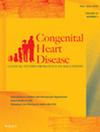Disharmonious Ventricular Relationship and Topology for the Given Atrioventricular Connections. Contemporary Diagnostic Approach Using 3D Modeling and Printing
IF 1.2
4区 医学
Q4 CARDIAC & CARDIOVASCULAR SYSTEMS
引用次数: 3
Abstract
In the last issue, two case reports separately present examples of the extremely rare and complex congenital heart diseases that show concordant atrioventricular connections to the L-looped ventricles in the presence of situs solitus. Both cases highlight that the relationship between the two ventricles within the ventricular mass is not always harmonious with the given atrioventricular connection. Such disharmony between the connections and relationships requires careful assessment of the three basic facets of cardiac building blocks, namely their morphology, the relationship of their component parts, and their connections with the adjacent segments. 3D imaging and printing can now facilitate an otherwise difficult diagnosis in such complex situations. Rotation of either the 3D images or the models permit accurate assessment of the ventricular topologic pattern by creating the right ventricular en-face septal view, thus facilitating placement of the observer’s hands. As we now emphasize, an alternative approach, which might prove more attractive to imagers, is to rotate the ventricular mass to provide the ventricular apical view, thus permitting determination of the ventricular relationship without using the hands.给定房室连接的不和谐心室关系和拓扑结构。使用3D建模和打印的当代诊断方法
在上一期中,两个病例报告分别介绍了极其罕见和复杂的先天性心脏病的例子,这些疾病在孤立体位存在时显示与l环心室一致的房室连接。这两个病例都突出了心室肿块内两个心室之间的关系并不总是与给定的房室连接协调一致。这种连接和关系之间的不和谐需要仔细评估心脏构建块的三个基本方面,即它们的形态,它们的组成部分的关系,以及它们与相邻部分的连接。3D成像和打印现在可以在这种复杂的情况下促进原本困难的诊断。旋转3D图像或模型可以通过创建右心室面间隔视图来准确评估心室拓扑模式,从而方便观察者的手的位置。正如我们现在强调的,另一种可能对成像人员更有吸引力的方法是旋转心室肿块以提供心室顶点视图,从而允许在不使用手的情况下确定心室关系。
本文章由计算机程序翻译,如有差异,请以英文原文为准。
求助全文
约1分钟内获得全文
求助全文
来源期刊

Congenital Heart Disease
CARDIAC & CARDIOVASCULAR SYSTEMS-
CiteScore
0.40
自引率
33.30%
发文量
37
审稿时长
6-12 weeks
期刊介绍:
Congenital Heart Disease is an open-access journal focusing on congenital heart disease in children and adults. Though the number of infants born with heart disease each year is relatively small (approximately 1% of the population), advances in treating such malformations have led to increased life spans for this population. Consequently, today most patients treated for congenital heart disease are over the age of 20. What are the special needs of adults with congenital heart disease? What are the latest developments in the care of the fetus, infants, and children? Who should treat these patients? How should they be treated?
Congenital Heart Disease focuses on these questions and more. Conceived as a forum for the most up-to-date information on congenital heart disease, the journal is led by Editor-in-Chief Vladimiro L. Vida, MD, Ph.D., Professor in Cardiac Surgery, University of Padua in Italy, as well as an international editorial board. Congenital Heart Disease publishes articles on heart disease as it relates to the following areas:
• Basic research of congenital heart disease
• Clinical pediatric and adult cardiology
• Cardiac imaging
• Preventive cardiology
• Diagnostic and interventional cardiac catheterization
• Electrophysiology
• Surgery
• Long-term follow-up, particularly as it relates to older children and adult congenital heart disease
• Exercise and exercise physiology in the congenital patient
• Post-op and critical care
• Common disorders such as syncope, chest pain, murmurs, as well as acquired disorders such as Kawasaki syndrome
The journal includes clinical studies, invited editorials, state-of-the-art reviews, case reports, articles focusing on the history and development of congenital heart disease, and CME material. Occasional issues focus on special topics.
Readership: Congenital Heart Disease was created for pediatric cardiologists; adult cardiologists who care for patients with congenital heart disease; pediatric and pediatric cardiology nurses; surgeons; radiologists; anesthesiologists; critical care physicians and nurses; and adult support staff involved in the care of patients with congenital heart disease.
 求助内容:
求助内容: 应助结果提醒方式:
应助结果提醒方式:


